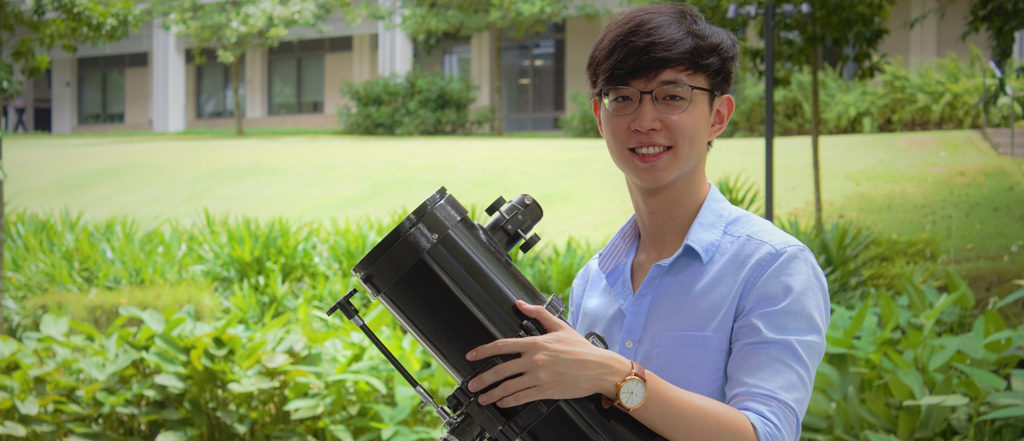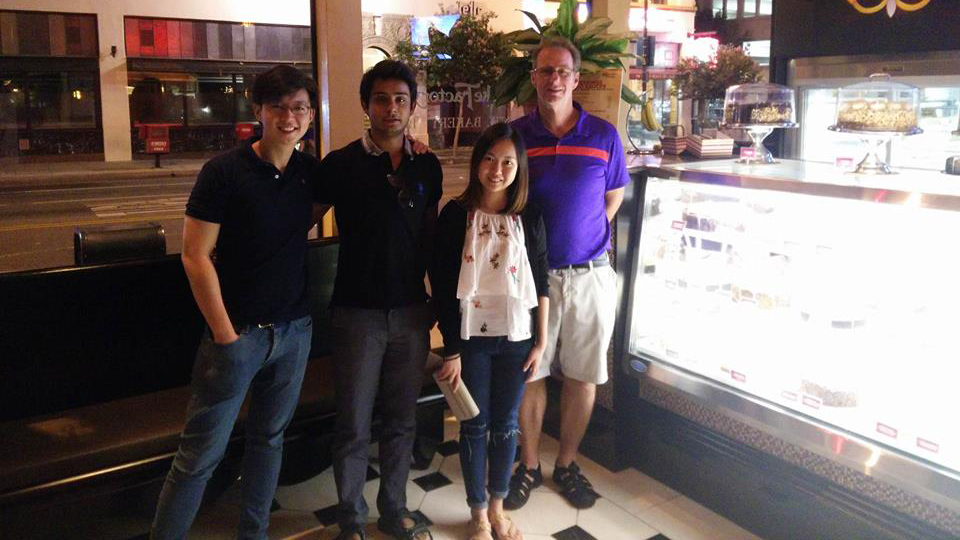Yale-NUS students publish in prestigious astrophysics journal
Three Yale-NUS students recently published a paper in the prestigious Astrophysical Journal, a rare achievement for undergraduates.
Titled “Optical and Infrared Photometry of the nearby SN 2017cbv”, the paper deals with an explosion in the sky, also known as a supernova, or “SN”, that was detected in March 2017.
“Coincidentally, the supernova was detected at the same time we were taking a class on observational astronomy, which enabled us to begin researching on the supernova immediately,” said first author Jerrick Wee (photo below, Class of 2019).
 Image by Khang Huynh for Yale-NUS College.
Image by Khang Huynh for Yale-NUS College.
Jerrick said the crux of the paper was determining the distance of the supernova from Earth, which is crucial to monitoring the rate of expansion of the universe. “The particular supernova we were looking at was one of the closest of its kind, and hence a critical data point for cosmologists,” he said.
The second and third authors are Nilotpal Chakraborty and Wang Jiayun respectively (both Class of 2019). The fourth author is Professor Bryan Penprase, who taught the class on observational astronomy at Yale-NUS College in 2017.
 The authors at Pasadena, California. From left: Jerrick Wee, Nilotpal Chakraborty, Wang Jiayun and Professor Bryan Penprase. Image provided by Jerrick Wee.
The authors at Pasadena, California. From left: Jerrick Wee, Nilotpal Chakraborty, Wang Jiayun and Professor Bryan Penprase. Image provided by Jerrick Wee.
It is unusual for undergraduates to publish in top scientific journals like Astrophysical Journal, and even more so for one to be listed as the first author. Jerrick shared that there was an “interesting convergence of classes that eased my journey to the publication”.
The first was taking a Special Seminar in his sophomore year by Visiting Professor Meg Urry, Yale University’s Israel Munson Professor of Physics.
“The class required me to look into some of the most recent literature on black holes. That paved the way to my familiarity with using the treasure trove called the Astronomical Database System which enabled my endless scouting for papers related to my research,” he said.
The second was the final project in the Observational Astronomy class, where Jerrick picked up Python, a programming language, to measure the brightness of all the stars in an image of a globular cluster of about 50,000 stars. “That problem forced me to get up to speed with Python for data extraction and analysis in the project,” he said.
The database system and Python “eventually became pivotal instruments for my research on the supernova,” Jerrick said.
Jerrick’s interest in astronomy and astrophysics has been a lifelong affair. He first fell in love with astronomy when his parents bought him an encyclopedia when he was nine years old.
“I had my imagination illuminated by the first page on cosmogony,” he said. “For astrophysics, it began when I was 16 after reading about General Relativity and Quantum Mechanics in Brain Greene’s The Elegant Universe.”
He became interested in conducting research in these fields after taking Professor Penprase’s class. “I learned how, by using remotely operated telescopes, transient astronomy research could be done even under light-polluted skies and without a research-grade telescope in Singapore,” he said.
A stint at Caltech’s Summer Undergraduate Astronomy Institute in Pasadena, California solidified his passion for astronomy research.
Jerrick, a philosophy major who is currently writing his final-year capstone project on Friedrich Nietzsche’s philosophy of culture and his axiology, is still exploring his post-graduation options, given his diverse interests.
Something he has been thinking about is joining the commercial space industry. Also known as the NewSpace industry, this refers to private companies that develop cheaper access to space and space technologies previously only possible with enormous governmental efforts.
At the moment, he is working for Bhattacharya Space Enterprises, a Singapore-based company that is building a space-tech ecosystem through space education.
“One of the projects that our company did was to guide students from the Singapore American School to design and launch an experiment to the International Space Station to be tested. We’re also coordinating the World Space Week 2018, an international celebration of space science and technology organised by the United Nations,” he said.
His most recent project is developing an experiment module to beam instructions up to the International Space Station to conduct various experiments in a zero-gravity environment.
Reflecting on his time at Yale-NUS thus far, Jerrick noted that it has been “a unique experience” compared to his friends in other institutions.
“There is a principle I adopted from Walter Pater, a philosopher of aesthetics, that serves as a guiding light to my life in general: ‘What we have to do is to be forever curiously testing new opinions and courting new impressions, never acquiescing in a facile orthodoxy, of Comte, of Hegel, or of our own.’”
“In this sense,” Jerrick said, “I’d like to do my education justice by courting more unique experiences in life.”





